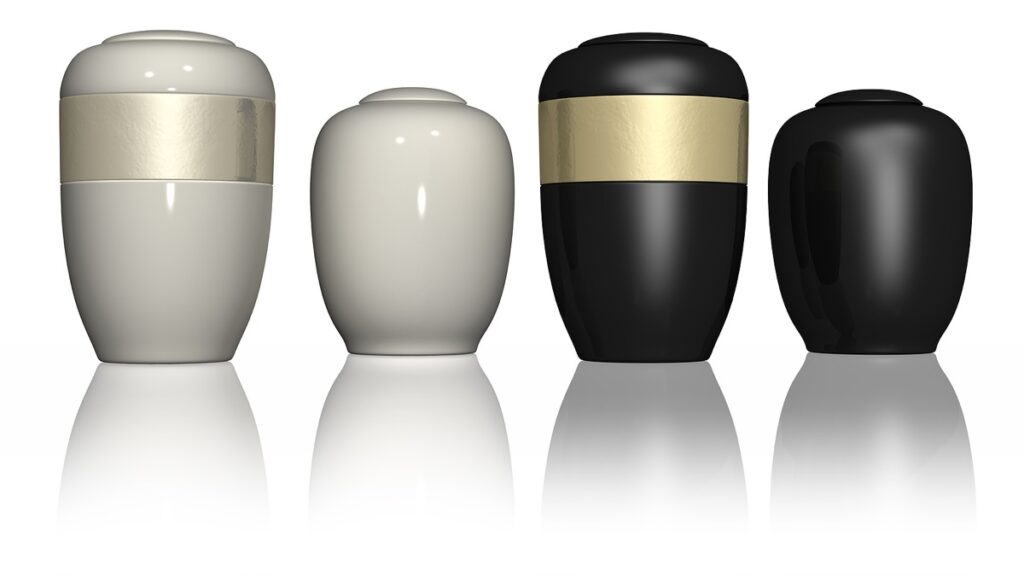Choosing a cremation urn for a loved one can be a daunting task. There are many factors to consider and a wide variety of options available, so narrowing things down can be challenging. However, we have listed some advice to make this task easier. Below are 10 tips for buying an urn.
#1: Understand cremation options.
There are generally two types of cremation to choose from – flame cremation and aquamation. Both options produce cremated remains or ashes, but the cremation processes and end-products differ.
Flame cremation is the more traditional option involving exposing a body to extreme heat. This consumes most organic matter in the body, leaving behind bone fragments. The bones are reduced to create a coarse, grey or brown powder.
Aquamation uses the chemical process of alkaline hydrolysis to cremate remains. The body is treated with water, alkali (potassium hydroxide), pressure, and heat. This creates a reaction that speeds up decomposition, leaving behind bone fragments and a sterile liquid. The fragments are pulverized into a smooth, white or tan powder, and the liquid is released as wastewater.
It is vital to have a basic understanding of these processes because they may impact your urn options. For example, aquamation produces 20 to 30 per cent more ashes than flame cremation, so a larger urn may be necessary. Additionally, the colour and consistency of the ashes are slightly different, so it may affect options that use the ashes to create something (e.g., jewelry). Cost also varies slightly between flame cremation and aquamation, so this may reduce the budget allotted for an urn.
#2: Pick the correct urn size
Urns come in many sizes, so it is essential to ensure the chosen urn has the capacity to hold all or some of the ashes.
Urn capacity is typically measured in cubic inches. Below is a general guideline to help families determine the cubic inches necessary to hold their loved one’s ashes.
Each pound of body weight before cremation equals approximately one cubic inch of ashes with flame cremation. Therefore, if someone weighed 170 lbs. before cremation, they would need an urn with a capacity of at least 170 cubic inches.
Aquamation produces 20 to 30 per cent more ashes than flame cremation, so there is no longer a 1:1 ratio. Instead, each pound of body weight will make approximately 1.2 to 1.3 cubic inches of ashes. Therefore, an individual weighing 170 lbs. before aquamation would need an urn with a capacity of at least 204 to 221 cubic inches.
#3: Look at different urn types
The standard adult urn is designed to hold 200 cubic inches, but this may not be the best option for everyone. Fortunately, there are various urn styles available to consumers. Below are examples of common urn types:
- Keepsake urn. This urn is a miniature urn designed to hold a portion of cremated remains. Keepsake urns allow for easier sharing of ashes and are a good option for when part of the remains will be scattered and some will be kept.
- Companion urn. This urn is designed to store the cremated remains of two people. Companion urns usually come in two variations – one version has a single compartment where the ashes will be mixed, and the other has a double compartment so the ashes will remain together but separated. The urn style is popular for couples and families.
- Infant urn. Infant urns have smaller capacities, designed to hold the ashes of a child or infant that has died. It often displays child-related themes.
- Urn jewelry. This is an accessory made with a portion of the ashes or has a compartment for some ashes. It is ideal for people that want to keep cremated remains with them in their day-to-day lives.
#4: Choose the urn material
Urns are available in many materials. The choice comes down to personal preference but may be impacted by what will be done with the ashes. This will be discussed further below. First, however, here are common urn materials and their features.
- Wood Urns. Wood urns offer more customization than other options. It can come in various wood types, such as bamboo, maple, oak, pine, cedar, etc. and can be engraved easily. It is also not very delicate and easy to clean. However, harsh cleaners and soap should be avoided.
- Ceramic and ceramic-like materials. Urns made from ceramics and materials like glass, crystal, marble, and stone are easy to clean and maintain but are more delicate and prone to breaking. Therefore, individuals must be more cautious when placing and moving it. These urns can also be more challenging to engrave than wood variants.
- Biodegradable urns. These urns are made from biodegradable materials, such as paper, cardboard, clay, barks, etc. These substances will naturally decompose over time, making biodegradable urns an eco-friendlier option.
#5: Establish your budget.
Cremation urns can cost anywhere from $20 to over $2,000. The price varies depending on the type, material, customization, etc. There are several options to suit all budgets, but the quality is something to consider. For example, a cheaper urn from Walmart may cost under $50 but be lower quality than a handmade urn from a local retailer charging double the cost.
It is a good idea to look at different types and materials to get an idea of the price and set a budget that provides some wiggle room. Fees can add up quickly, so it is vital to look at the extra costs, such as engraving and shipping.
#6: Consider placement or burial location
Certain urn materials and styles are more delicate than others. Therefore, it is crucial to consider the location where the urn will be kept. For example, if it is being held on a mantle, a wooden urn may be more suitable than a ceramic urn because it is less likely to break if it falls. Similarly, a biodegradable urn may not be well-suited to be interred in a columbarium because it will decompose over time.
#7: Factor in long-term plans.
Like location, it is essential to factor in what will be done with the urn initially and in the future. For example, if the plan is to scatter the ashes, purchasing an urn may not be necessary since crematoriums typically return the ashes in a temporary container. If the goal is to bury the urn in the ground, a biodegradable urn will be the better option since it will decompose and not leach harsh chemicals, such as varnish, into the surrounding soil. If the ashes are shared, purchasing several small keepsake urns may be better (and cheaper) than a standard adult-sized urn.
#8: Shop around
Urns can be purchased directly from a funeral provider, at second-hand shops, via local retailers, custom-made, online, and more. It is also common for manufacturers to have their products available at many stores and sites. Therefore, it is essential to keep an eye out for deals when purchasing an urn. For example, funeral providers often hike up the price of urns sold in their facility. But the same urn may be available directly from the manufacturer for much cheaper.
Similarly, one store may sell an urn at a higher price but offer free shipping, so the final cost is cheaper than on another site. It is also crucial to consider return policies, especially when buying online, because pictures may look different than in person. And if all urns are final sale, the extra money will be spent to purchase a new urn.
#9: Honour the deceased person’s wishes
Although urns are more for the family and friends of the deceased, it is good to consider what they may have wanted. If they were an environmentalist, a biodegradable urn would be a good option. The ashes can also be combined with a seed and grow into a tree, giving back to the environment. If the deceased were part of the armed forces, a veteran urn displaying patriotic symbols and imagery may be ideal. Urns can be a great way to showcase the deceased personality and celebrate their life and legacy.
#10: Get input from friends and family
Purchasing an urn and choosing what will be done with cremated remains may be the responsibility of one family member or several. Regardless, the death will likely impact many people, and it is a nice gesture to take input and suggestions from those closest to the deceased. In addition, it allows loved ones to pay tribute to the deceased in a meaningful way.

